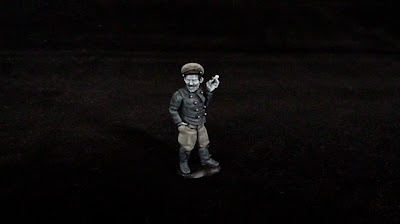A few months ago I wrote a post in which I dropped a hint that the next addition to my greyscale Great War project would feature a 'mystery vehicle'. I alluded that this vehicle had gained it's fame not for it's military power, but rather because it was completely unthreatening, being both unarmed and unarmoured. The comments that followed had several excellent guesses ranging from the common artillery limber horse to the London double-decker bus that ferried troops behind the lines. These are certainly great examples, worthy of projects in of themselves, but still not quite what I had in mind.
In the end the brass ring must go to Sylvain for correctly guessing that the mystery vehicle is the humble Paris taxi, the 1905 Renault Type AG-1, better known as the 'Taxi de la Marne'.
In the end the brass ring must go to Sylvain for correctly guessing that the mystery vehicle is the humble Paris taxi, the 1905 Renault Type AG-1, better known as the 'Taxi de la Marne'.
 |
| Painting by Brian Sanders. |
As the French madly tried to reorient their axis of operations it was decided by the military governor of Paris, General Gallieni, to call upon the taxis of the city to transport men to the front (which at that time was only about 50 km away). The cab drivers of Paris answered and about 6,000 men of the 7th Infantry Division were driven to the front, many of them in Renault taxis.
Though the Taxis de la Marne are often touted as a symbol of French patriotism it must be stated that the pragmatic Parisian cabbies did have their meters running and the total cost to the French treasury in fares was 70,102 francs. Nothing is recorded on how well the drivers were tipped...
This is a 1:43 diecast model from RIO Models of Italy. I'm afraid to say it came out-of-the-box already beautifully painted in vibrant colours, so I was more than a little hesitant to prime it black in order to attempt a greyscale effect on it. Nonetheless I forged ahead and am fairly satisfied with how it turned out.
I've also included a driver model I sourced from Bob Murch's characterful range of Pulp Figures. To me this figure epitomizes that Parisian sense of detachment and sang-froid in which we often like to stereotype the Gallic race.
I did up this figure in homage to the great French driver Georges Boillot. His overall pose, particularly the way he's holding his cigarette, makes me smile.
 |
| Georges Boillot |
Boillot won the French Grand Prix at Dieppe in 1912, at Amiens in 1913 and set a speed record at the Indianapolis 500 the following year.
 |
| Boillot in 1914, racing for Peugeot at the Indianapolis 500. |
When war broke out in 1914 Boillot was assigned as the personal driver to General Joffre during the Battle of the Frontiers. During those first furious weeks of the war Joffre was famed 'to be everywhere at once' - most of this came from the supreme (Joffre's aides would argue 'reckless') driving skills of Boillot, who whisked the General from front to front at high speeds, along roads congested with soldiers, refugees and military supplies.
 |
| The Driver taking a break in a current work-in-progress, a 1909 Thomas Flyabout. |
As France continued to suffer from the war Boillot wanted to participate more actively. So in 1915 he transferred into the Service Aeronautique where he had great success serving as a fighter pilot, being awarded both the Croix de Guerre and the Legion d'Honneur. Nonetheless, like so many airmen during the early war, fate caught up with Boillot and in 1916 he was shot down and killed fighting in the skies over Verdun.

















































